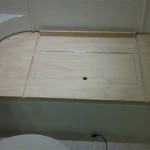Can't Remove Bathtub Faucet Handle: Troubleshooting and Solutions
Removing a bathtub faucet handle often appears to be a straightforward task. However, various factors can contribute to difficulty in its removal. This article explores common reasons why a bathtub faucet handle might be stuck and provides detailed instructions on how to troubleshoot and resolve these issues.
Understanding the anatomy of a bathtub faucet handle and its connection mechanism is crucial before attempting removal. Most handles are attached to the faucet stem using either a screw or a threaded connection. Over time, mineral buildup, corrosion, and overtightening can cause these connections to seize, making removal challenging. Additionally, discrepancies between the type of handle, type of stem, and existing plumbing can lead to complications needing unique approaches.
Identifying the Type of Faucet Handle
Before attempting any removal process, identifying the type of bathtub faucet handle is paramount. Different types of handles require different removal techniques. Common types include:
- Single-Handle Faucets: These faucets typically control both hot and cold water with a single lever. The lever is often secured with a set screw, usually located underneath the handle or on its side. Removing this screw allows the handle to be pulled off the stem.
- Two-Handle Faucets: These faucets have separate handles for hot and cold water. The handles can be secured with screws, threaded connections, or a combination of both. Decorative caps often conceal the screws.
- Diverter Faucets: These faucets feature a handle that diverts water between the bathtub spout and the showerhead. They can be similar to single or two-handle faucets in terms of attachment methods.
- Push-Button Faucets: Less common in bathtubs, these faucets use a push-button mechanism to control water flow. The handle is often integrated with the faucet body and might require specialized tools or knowledge to remove.
Once the type of faucet handle is identified, the appropriate removal technique can be applied.
Addressing Common Causes of Stuck Faucet Handles
Several factors can contribute to a faucet handle becoming stuck. Addressing these issues methodically can often lead to successful removal without causing damage to the faucet or plumbing.
Mineral Buildup: Hard water contains minerals such as calcium and magnesium, which can accumulate around the faucet handle and stem. This buildup can effectively glue the handle in place. Mineral deposits can accumulate swiftly, particularly where water evaporates along the handle's base. The resulting hardened crust can prevent the handle from moving freely. In areas with hard water, this is a consistently recurring problem.
Corrosion: Over time, metal components of the faucet handle and stem can corrode, especially in damp environments. Corrosion creates rust and other byproducts that can bind the handle to the stem. Galvanic corrosion, caused when two dissimilar metals are in contact in the presence of an electrolyte, can accelerate the corrosion process.
Overtightening: Previous attempts to tighten the handle or the screw securing it can result in the handle becoming jammed. Excessive force can deform the handle or strip the threads of the screw, making removal difficult. Many individuals inadvertently overtighten screws, thinking this provides more stability when in reality, it can cause significant damage.
Stripped Screws: The screw that secures the handle to the stem can become stripped, preventing a screwdriver from adequately gripping it. This is a common issue, especially with older faucets or when using the wrong size screwdriver. Repeated attempts to unscrew a stripped screw only exacerbate the problem.
Step-by-Step Guide to Removing a Stuck Faucet Handle
Follow these steps to systematically address a stuck bathtub faucet handle. Safety is paramount - always shut off the water supply to the faucet before beginning any repairs.
- Preparation: Gather necessary tools, including a screwdriver set (Phillips and flathead), penetrating oil, a rubber mallet, pliers (optional), and a faucet handle puller (optional). Cover the drain to prevent small parts from falling in. Wear safety glasses to protect eyes from debris.
- Inspection: Carefully examine the handle and the surrounding area for any visible screws, caps, or other retaining mechanisms. Note the type of faucet handle and its construction. If there is a cover on the handle, begin by removing it.
- Loosen the Screw: If a screw is visible, attempt to loosen it with a screwdriver of the appropriate size. Apply penetrating oil to the screw head and wait several minutes to allow it to seep into the threads. If the screw is stripped, try using a rubber band or steel wool between the screwdriver and the screw head to improve grip. A screw extractor set may be needed if the screw is severely stripped.
- Apply Penetrating Oil: If no screw is visible, or after loosening the screw, apply penetrating oil around the base of the handle where it meets the faucet body. Allow the oil to penetrate for at least 15-30 minutes. Reapply the oil periodically during this time. Penetrating oil is crucial for breaking down mineral deposits and corrosion.
- Gentle Tapping: After the oil has had time to penetrate, gently tap the handle with a rubber mallet. This can help to dislodge it from the stem. Avoid using excessive force, as this could damage the handle or stem. Tap from different angles to help loosen any binding.
- Handle Puller (If Needed): If the handle remains stuck, consider using a faucet handle puller. This tool is designed to provide a controlled and even force to pull the handle off the stem without causing damage. Follow the manufacturer's instructions for using the handle puller.
- Pliers (As a Last Resort): As a last resort, pliers can be used, but extreme caution is needed. Wrap the handle with a cloth to protect it from scratches. Gently grip the handle with the pliers and attempt to twist and pull it off the stem. Avoid applying excessive force, as this can damage the handle or the underlying plumbing.
- Cleaning and Lubrication: Once the handle is removed, clean the faucet stem and the inside of the handle with a wire brush to remove any remaining mineral buildup or corrosion. Apply plumber's grease to the stem before reattaching the handle. This will help prevent future sticking.
Preventative Measures for Future Issues
Taking proactive steps can help prevent future problems with bathtub faucet handles. These measures minimize the likelihood of handles seizing or becoming difficult to remove.
Regular Cleaning: Periodically clean the faucet handles and surrounding area to remove mineral buildup and soap scum. Use a mild cleanser and a soft cloth. Avoid abrasive cleaners, as these can damage the finish of the faucet. Regular cleaning prevents the accumulation of deposits that cause handles to stick.
Lubrication: Apply plumber's grease to the faucet stems and handles periodically. This lubrication helps to prevent corrosion and makes it easier to remove the handles in the future. Lubrication creates a barrier against moisture and mineral deposits, extending the life of the faucet components.
Water Softener: If hard water is a persistent problem, consider installing a water softener. This device removes minerals from the water, reducing the likelihood of mineral buildup in faucets and other plumbing fixtures. A water softener offers a long-term solution to hard water issues.
Proper Installation and Tightening: When installing or reattaching faucet handles, avoid overtightening the screws. Tighten the screws just enough to secure the handle without stripping the threads. Overtightening can lead to handles becoming stuck or damaged.
Regular Inspection: Periodically inspect the faucet handles for any signs of corrosion or damage. Addressing these issues early can prevent them from escalating into more significant problems. Early detection allows for timely intervention and prevents more costly repairs later on.
Adhering to these preventative measures helps to maintain the functionality and longevity of bathtub faucet handles, reducing the frustration of dealing with stuck or difficult-to-remove handles.

How To Remove Stubborn Bathtub Faucet Handles

Stubborn Faucet Handle Won T Budge
:max_bytes(150000):strip_icc()/how-to-replace-a-bathtub-faucet-5210836-04-7b7d953ade8141c1a4750f082aad38d4.jpg?strip=all)
How To Replace A Bathtub Faucet

How To Remove A Stuck Shower Faucet Handle

How To Fix A Leaking Bathtub Faucet Diy Family Handyman

How To Remove A Stubborn Bathtub Faucet Handle Hunker
:max_bytes(150000):strip_icc()/how-to-replace-a-bathtub-faucet-5210836-hero-dbea72550ab646829a3fb289eb4e9a65.jpg?strip=all)
How To Replace A Bathtub Faucet

How To Replace Bathtub Faucet Handles
:max_bytes(150000):strip_icc()/how-to-replace-a-bathtub-faucet-5210836-09-018c0bd035424eae9f9b55faff2d7605.jpg?strip=all)
How To Replace A Bathtub Faucet

What To Do When Your Bathtub Faucet Won T Turn Off In Dallas Deluxe Plumbers
Related Posts








